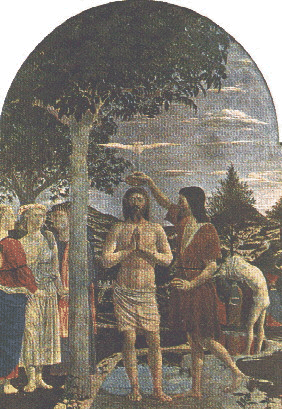The Baptism of Christ

The Baptism of Christ (c.1450) by Piero della Francesca is located in London's National Gallery. This painting depicts the story of Christ's baptism in the Jordan by John the Baptist. Christ is portrayed as a rough Tuscan farmer. Another convert undresses, ready for his turn and three angels indicate the importance of the event by their glances. The landscape background applied the effect of aerial perspective to create depth. That all takes place in a recognizable Tuscan landscape.
The landscape is used as disguised symbolism - Christ symbolized in the tree, God in the blue sky and Holy Spirit in the dove. The number of angels (i.e. 3) is symbolic of the Holy Trinity. Piero tended to see spiritually in the landscape around him without needing overt symbols and thus naturalizes the traditional iconography of the scene.
This painting was commissioned for the Priory of San Giovanni in San Sepolcro. The costumes and hats of the background figures which are typical of the fashions of the Byzantine visitors to Florence at this time.
Baptism of Christ is one of Piero's masterpieces that he finished before The Legend of the True Cross cycle. The landscape in this work is considered to be fully developed and is quite remarkable for its time. The painting showed Piero's developed style of the early Renaissance.
Baptism of Christ shows features of early Renaissance style. The space creation is achieved primarily by the diminution of figures in space, and reinforced by the path of the river winds back in distance. This painting is sectioned into thirds both horizontally and vertically, structured by the underlying mathematical construction. Colour is also used as a form of aerial perspective to lead the eye further back into the painting, while still retaining its decorative functions.
The area portrayed is the local area around San Sepolcro. Light in Tuscany in summer is strong and colour appears bleached and shadowless giving a translucent effect to pale colours like white.
Piero constructs figure in the basis of geometric forms, i.e. the architectonic approach. The humans in the painting reveal the geometric shapes, volume in sphere, oval, cylinder or ellipses.
Baptism of Christ is referenced to the Historia for several concepts. Firstly, the biblical subject matter, giving an impression of grandeur. The figures are ordered and projected their emotions onto the viewer, emphasized by the three angels. Light and shade are used for the modeling of form. The use of 'link-figure' is also illustrated by the angel on the right as the 'gazing figure'; angel on the left, 'pointing figure'; angel in the middle, 'choric figure'.
Back to Top
Back to Home


